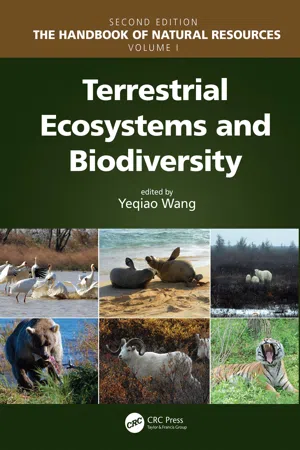
- 411 pages
- English
- ePUB (mobile friendly)
- Available on iOS & Android
Terrestrial Ecosystems and Biodiversity
About This Book
Authored by world-class scientists and scholars, The Handbook of Natural Resources, Second Edition, is an excellent reference for understanding the consequences of changing natural resources to the degradation of ecological integrity and the sustainability of life. Based on the content of the bestselling and CHOICE-awarded Encyclopedia of Natural Resources, this new edition demonstrates the major challenges that the society is facing for the sustainability of all well-being on the planet Earth. The experience, evidence, methods, and models used in studying natural resources are presented in six stand-alone volumes, arranged along the main systems of land, water, and air. It reviews state-of-the-art knowledge, highlights advances made in different areas, and provides guidance for the appropriate use of remote sensing and geospatial data with field-based measurements in the study of natural resources.
Volume 1, Terrestrial Ecosystems and Biodiversity, provides fundamental information on terrestrial ecosystems, approaches to monitoring, and impacts of climate change on natural vegetation and forests. New to this edition are discussions on biodiversity conservation, gross and net primary production, soil microbiology, land surface phenology, and decision support systems. This volume demonstrates the key processes, methods, and models used through many case studies from around the world.
Written in an easy-to-reference manner, The Handbook of Natural Resources, Second Edition, as individual volumes or as a complete set, is an essential reading for anyone looking for a deeper understanding of the science and management of natural resources. Public and private libraries, educational and research institutions, scientists, scholars, and resource managers will benefit enormously from this set. Individual volumes and chapters can also be used in a wide variety of both graduate and undergraduate courses in environmental science and natural science at different levels and disciplines, such as biology, geography, earth system science, and ecology.
Frequently asked questions
Information
1
Assessment of Community-Based Activities to Reduce Human–Elephant Conflict in Nepal
Introduction
Table of contents
- Cover
- Half Title
- Series Page
- Title Page
- Copyright Page
- Table of Contents
- Preface
- About The Handbook of Natural Resources
- Acknowledgments
- Aims and Scope
- Editor
- Contributors
- SECTION I Biodiversity and Conservation
- 1 Assessment of Community-Based Activities to Reduce Human–Elephant Conflict in Nepal
- 2 Biodiversity: Agriculture
- 3 Biodiversity: Climate Change
- 4 Biodiversity: Conservation
- 5 Biodiversity: Habitat Suitability
- 6 Biodiversity: Tropical Agroforestry
- 7 Biodiversity: Values
- 8 Biomes
- 9 Decision-Making and Monitoring Strategies in Natural Resource Management and Conservation
- 10 Diversity: Species
- 11 Exotic and Invasive Species
- 12 Keystone and Indicator Species
- 13 Population Genetics
- 14 Prioritizing Conservation Sites for Biodiversity Protection in Uganda
- 15 Weeds: Seed Banks and Seed Dormancy
- SECTION II Ecosystem Type, Function, and Service
- 16 Community Forestry: Sustainability and Equity Issues
- 17 Ecosystem Services: Evaluation
- 18 Ecosystem Services: Land Systems Approach
- 19 Ecosystem Services: Pollinators and Pollination
- 20 Ecosystems: Diversity
- 21 Ecosystems: Forest Nutrient Cycling
- 22 Ecosystems: Functions and Services
- 23 Ecosystems: Soil Animal Functioning
- 24 Ecotone
- 25 Environmental Goods and Services: Economic and Non-Economic Methods for Valuing
- 26 Forests: Temperate Evergreen and Deciduous
- 27 Forests: Tropical Rain
- 28 Savannas and Grasslands
- SECTION III Ecological Processes
- 29 Agriculture: Organic
- 30 Crops and the Atmosphere: Trace Gas Exchanges
- 31 Desertification
- 32 Ecological and Evolutionary Processes
- 33 Ecology: Functions, Patterns, and Evolution
- 34 Land Plants: Origin and Evolution
- 35 Leaves: Elevated CO2 Levels
- 36 Net Ecosystem Production (NEP)
- 37 Nitrogen Deposition and Deyeuxia angustifolia Encroachment in Alpine Tundra
- 38 Nitrogen Fixation: Biological
- 39 Ozone: Crop Yield and Quality Effects
- 40 Global Plant Breeding
- SECTION IV Ecosystem Monitoring
- 41 Altitudinal Belts: Global Mountains, Patterns, and Mechanisms
- 42 Biodegradation and Bioremediation
- 43 Decision Support: Monitoring, Reporting, and Forecasting Ecological Conditions of Appalachian Trail
- 44 Estimation of Net Primary Production and Its Spatial and Temporal Variations in Northeast China: Remote Sensing
- 45 Optical Properties of Reflected Light from Leaves
- 46 Remote Sensing of CO2 Emissions from Wildfires
- Index